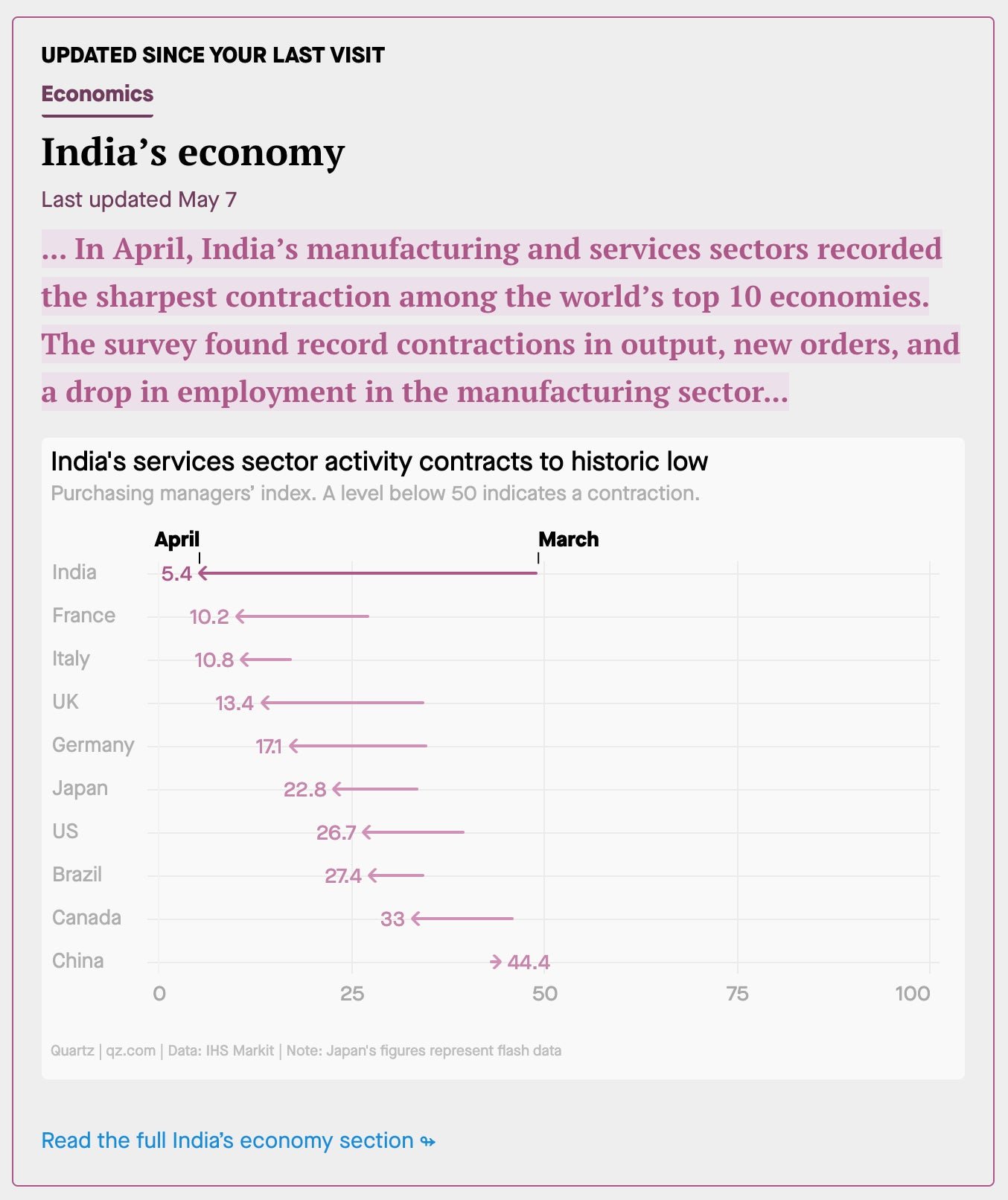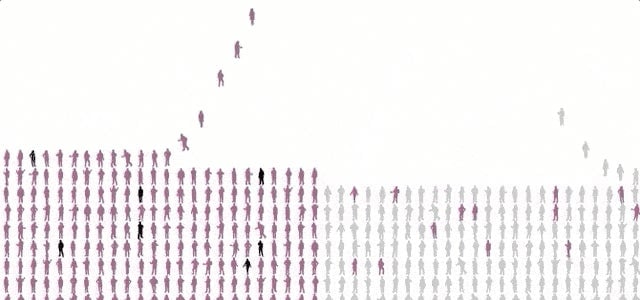Coronavirus: Emission impossible
Hello Quartz readers,

Hello Quartz readers,
Cities around the globe are settling into a second month of lockdown, as others reopen to a new set of norms. Those renewed freedoms bring with them more choices—Can I meet up with a friend? Should I go to the office? Will I stop wearing these sweatpants?—and decision fatigue is starting to set in. We’re all trying to stay positive…but how are you doing really?
We put that question to readers of Quartzy, our newsletter on living well in the global economy, and invited them to send us any and all corona-grievances, however petty or embarrassing. Boy did we hear back.
- Laura: “I’m a hugely enthusiastic home cook, but on Day 36 of making complex treat dinners with hand-drawn menus, I’m a bit over all that. Now scuffing around my house in fluffy socks and calling it ‘cleaning.’”
- Carol: “I’m seeing gloves and masks littering parking lots, mainly the grocery store parking lots. Really!?!”
- Tori: “This week I felt envious of a pear in my fridge. Its sticker read Argentina, and as I cut the fruit I was awash in resentful longing as I thought of how much of the world it had seen before arriving in my home.”
As Quartzy notes, “acknowledging that something sucks and you’re struggling is not the same as whining.” Really, both can be cathartic. If you want to get a corona complaint off your chest, try ✉️sending it our way.
And if you’re interested in more Quartzy wisdom, we’ll make it easy.
Now, let’s get started.
Gooaaaaaal…?
The economic shutdown has taken a huge bite out of global greenhouse gas emissions. According to a recent analysis from research outfit Carbon Brief, it could add up to the largest one-year drop in emissions in history: 2,000 metric tons of CO2, equal to about 5.5% of the planet’s 2019 carbon footprint. The International Energy Agency says the decline could be as high as 8%. Before coronavirus, global emissions were expected to increase at least 1% this year.
That’s an astounding reversal. But it reveals a stark reality: Even emissions reductions on this scale wouldn’t be enough to limit global warming to 1.5°C above pre-industrial levels, the goal set out in the 2015 Paris Agreement. To make that possible, emissions need to drop 7.6% every year this decade, according to the UN.
How is everything we’re living through—shuttered factories and construction sites, grounded airplanes, parked cars, falling electricity use, vanishing oil demand—not enough to get us on track? In the short term, it actually is: Carbon Brief found that during the peak of its shutdown, China’s emissions dropped 25%; in April, India’s may fall by 30%. The problem is that shutdowns are temporary.
“Fundamentally nothing has changed,” says Simon Evans, a biochemist and Carbon Brief’s deputy editor. “Once people get back in their cars, it’s the same cars. Reaching any climate goal requires structural shifts.”
Those shifts are outlined in detail in the Intergovernmental Panel on Climate Change’s 2018 special report on 1.5°C, which painted a fairly grim picture of our odds of reaching that goal. They all boil down to a few key steps to eliminate our use of fossil fuels:
- Make the electric grid work on 100% renewable energy.
- Make cars and everything else that consumes fossil fuels run on electricity instead—and use less of it.
- Deploy high-tech fixes for things that are hard to run on electricity with current technology, like airplanes, and to remove CO2 that’s already in the atmosphere.
- Reduce emissions from agriculture by using resources, including land, more efficiently.
It’s clear that travel restrictions and social distancing don’t do much to advance those goals; even if they did, Evans said, there are few climate activists who think making millions of people suffer extreme economic and medical hardship is the best way forward. If anything, the shutdown has been detrimental to the clean energy industry. And depending on what kind of stimulus measures governments put in place after the pandemic, emissions could grow even faster than before.
Still, coronavirus may be a model for climate action in other ways. It reveals what the global community can achieve, in an incredibly short time, when it rallies around a common threat. And it underscores the urgency of what activists have been begging for years: Listen to scientists.
As I live and brief
There’s a lot going on these days, and it’s all happening fast. So this week we launched a one-stop shop for tracking Covid-19’s impact on major aspects of the global economy. We’re calling it the coronavirus living briefing. It has info on everything from bailouts to banking to air travel, plus charts that update with the latest figures, and plenty of links to in-depth coverage.
We’ll be updating this baby every weekday, and newly updated items are available to everyone. Best of all, recent updates since your last visit are highlighted for easy skimming.
Quartz members get exclusive access to the full briefing (including a nicely styled print option—crucial if you need a screenprieve.)

We hope tools like this one help with your news fatigue, and get you 🤔 about becoming a member. Thank you to each and every person that snags a 40% discount and joins the Quartz club.
(If you’re already a member, many thanks! We’d hug you but…you understand.)
Unstandardized testing
Last week we talked about serology tests, and the fluke of epidemiological statistics that makes test results misleading when only a small portion of a population has been infected. This week we’ll do you one better: Here’s a customizable simulation of an antibody test that illustrates the point. Bonus points for this mesmerizing animation.

Croc of “it”
You might have thought the “it” shoe of the pandemic was socks, but sales data suggests it’s actually a ventilated foam resin clog.
In its first-quarter footwear update, research firm NPD reported US sales of fashion footwear were down 24% year-over-year, in all categories except slippers (which are inexplicably included in “fashion footwear”). Athletic, or performance footwear was down 19%. The category that suffered the least was leisure footwear, which includes “sport lifestyle” kicks like hiking boots, water sandals, and “sport slides.” Leading that grouping was Crocs, the only top brand in NPD’s Retail Tracking Service to show growth in March.
Crocs’ Q1 revenue in the Americas rose, even though in-store retail fell by 9% compared to the first quarter in 2019. It was made up for by a 27% increase in wholesale sales and 14% from e-commerce. Crocs’ global sales were slightly down for the first quarter of 2020 due to sagging revenues from Asia.

Essential reading
- The latest 🌏 figures: 3,813,123 confirmed cases; 1,266,047 classified as “recovered.”
- Major key: Nigeria is unlocking its lockdown at maybe the worst time.
- The thirst is real: India’s liquor stores reopened after 40 days. People were…excited.
- Face off: How to hide yourself on Zoom, and why you should.
- No catfish, please: A Japanese aquarium asked people to call its lonely eels.
Our best wishes for a healthy day. Get in touch with us at [email protected], and live your best Quartz life by downloading our app and becoming a member. Today’s newsletter was brought to you by Jenni Avins, Tim McDonnell, Amanda Shendruk, David Yanofsky, and Kira Bindrim.